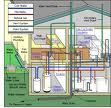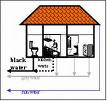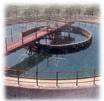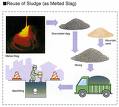



Different Systems of Plumbing?
Two pipe system
One pipe system
Single stack system
Partially ventilated single stack system.
Two pipe system
This is the best and most improved system of plumbing. Two sets of vertical pipes, one for excreta (night soil) as soil pipe and another for sullage...

TRAPS
Traps may be defined as fittings placed at the ends of the soil pipes or waste (sullage) pipes to prevent passage of foul gases from the pipes to the outside. The traps maintain water seal which is a standing water between the pipe and the outside to facilitate this. The water seal does not allow...

SANITARY PLUMBING SYSTEM
SANITARY FITTINGS
Plumbing is the practice, materials and fixtures used in the installation or maintenance of all pipes in connection with both water supply and sanitary systems within or adjacent to any building. The entire system of piping, fittings and the appurtenances are known as plumbing...

SEPTIC TANKS
Septic tanks are rectangular chamber can be either with single compartment or multiple compartments usually constructed below ground level for treating waste water.
The functions of the septic tanks are as follows:
They receive black water or excreta from the toilets.
Heavier solids settle to...

ON-SITE SANITATION
Commonly, on-site sanitation is equivalent to ‘household latrine’, but may also include facilities shared by several households living together on the same site. The more commonly known on-site sanitation includes facilities which are self-contained within the site, in contrast to...

SANITATION
SANITATION
” Sanitation” refers to all conditions that affect health, especially with regard to infection and specifically to the disposal of excreta, sullage and refuse from houses, hospitals and Universities. In 1950, the WHO Expert Committee on Environmental Sanitation defined...

DESIGN OF SEWAGE SYSTEM
SEWERAGE SYSTEM
The underground conduit for the collection of sewage is called sewer. A network of sewers and appurtenances for the collection and conveyance of sewage generated from each of the properties to sewage pumping station for pumping to sewage treatment and disposal is called Sewage...

Primary Water Treatment
SCHEMATIC DIAGRAM OF PRIMARY TREATMENT
The first stages of waste water ( sewage ) treatment are commonly physical and aimed to remove larger suspended solids from waste water, primarily using gravity to allow larger (heavy) particles to settle while allowing the remaining liquid to continue through...

Clariflocculator
Clariflocculator in Waste Water Treatments
In large waste water treatment plants, the flocculator and the clarifier are combined together to achieve economy in construction. The combined unit of flocculator and clarifier is known as clariflocculator in waste water treatment process....

Sludge Disposal
The sludge which is found in the bottom of a sedimentation tank in water treatment plant is primarily composed of water. The solids in the sludge are mainly flocs, excess coagulant, such as alum. Alum sludge has a solids concentration of only about 1 % when automatically removed from the basin, or...






 LIKE TO GET UPDATES
LIKE TO GET UPDATES  TO GET EXPERT GUIDE
TO GET EXPERT GUIDE